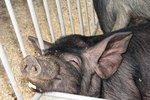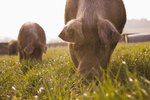
The Humane Society of the United States reports that hogs were first domesticated in Europe and Asia approximately 10,000 years ago and have been kept and bred in captivity by humans ever since. According to Duke University 67.8 million domestic pigs inhabited the United States as of 2007. The population continues to grow.
Terminology
The words hog and pig are generic terms used to describe swine, according to the University of Pennsylvania. The terms are interchangeable, but hog is typically used to describe growing animals while pig is used for immature animals. Female hogs are called sows, uncastrated males are called boars, and males who have been castrated are barrows. A suckling pig is still nursing off the sow. Weaners are piglets who are no longer sucking on the mother but weigh less than 40 pounds.
Breeding
Texas A&M University describes hogs as being the most prolific large mammal on Earth. A sow is considered sexually mature when she is between 6 and 8 months old. Most sows have their first litters when they are approximately 13 months old or older. Sows will give birth to five or more piglets in every litter and, when exposed to boars on a regular basis, will have between one and two litters each year.
Intelligence
Hogs are considered to be one of the smartest mammals. Pigs are also social, interacting freely with other pigs and with their human caretakers. Some owners allow their hogs to roam freely around their properties and even come into the house, because their social personalities can make them enjoyable companion animals. Smaller breeds of pig, such as potbellied pigs, can live as full-time indoors pets as long as they're socialized. Wild hogs are intelligent but also dangerous if frightened or threatened; they should not be approached.
Diet and Weight
According to Texas A&M University, hogs are omnivores. Being an omnivore means that hogs eat vegetation and meat. A hog normally eats between 3 percent and 5 percent of his body weight in food every day. Part of the job of a hog farmer is to supply hogs with a healthy, varied diet containing plenty of vegetables as well as some meat products. An average adult female hog weighs approximately 175 pounds and a male will weigh 200 pounds or more.
References
Photo Credits
-
Jupiterimages/Photos.com/Getty Images
Writer Bio
Jen Davis has been writing since 2004. She has served as a newspaper reporter and her freelance articles have appeared in magazines such as "Horses Incorporated," "The Paisley Pony" and "Alabama Living." Davis earned her Bachelor of Arts in communication with a concentration in journalism from Berry College in Rome, Ga.




